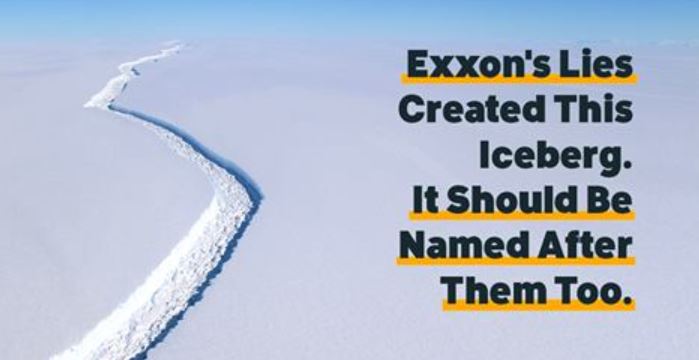
Let’s Name the Antarctic Larsen C Iceberg #ExxonKnew
“Exxon’s climate denial created this iceberg. It should be named after it too”.
Any day now we will truly witness climate change in action. Within days at worst, maybe weeks at best, scientists predict that a huge section of the Larsen C ice shelf in Antarctica will break off into the ocean, in what is called a major “calving” event.
The size of the US state of Delaware or the paradise island of Bali, the iceberg will be one of the biggest ever seen.
For months scientists have been watching the growing crack spread some 175 kilometres along the ice shelf with growing alarm. Now just 13 kilometres remain, keeping this chunk of ice attached to the main ice shelf.
In glacial terms, it is literally hanging by a thread.
“It’s keeping us all on tenterhooks,” Andrew Fleming of the British Antarctic Survey told Reuters earlier this week, adding “it feels like a niggling tooth” of a child as it comes loose.
According to scientists from Project MIDAS, which is a UK-based Antarctic research project which is investigating the effects of a warming climate on the Larsen C ice shelf: “When it calves, the Larsen C Ice Shelf will lose more than 10% of its area to leave the ice front at its most retreated position ever recorded; this event will fundamentally change the landscape of the Antarctic Peninsula.”
As the scientists point out, as the ice shelf is already floating, an iceberg breaking off does not directly impact sea level rise, although “the ice shelf is holding back land-based glaciers, which have a large sea level potential.”
So what should we name this vast new iceberg when it calves? The folks at 350.org have come up with a novel idea: Let’s name it #Exxonknew, because “50 years after learning the truth about climate change, Exxon’s climate denial is having increasingly devastating consequences.”
350.org outlines that the imminent calving of the vast iceberg is “one of the most dramatic displays of the destruction Exxon and their peers in the fossil fuel industry have unleashed upon the planet. Exxon’s climate denial created this iceberg. It should be named after it too.”
Ironically way back in the early sixties, a division of the company that would become Exxon, ran a full page ad in Life Magazine bragging about their ability to melt glaciers.
Later that decade, by 1968, a report for the American Petroleum Institute, on which Exxon is a prominent member, warned of the dangers of climate change and the risks to sea level rise if Antarctic glaciers melted.
Nine years later, in 1977 Exxon’s leaders were told directly by a senior company scientist, James F. Black about the looming climate crisis. “In the first place, there is general scientific agreement that the most likely manner in which mankind is influencing the global climate is through carbon dioxide release from the burning of fossil fuels,” he told Exxon’s Management Committee.
A year later, in 1978, one of the most seminal works on Antarctica was published by John Mercer from the Institute of Polar Studies, who concluded: “One of the warning signs that a dangerous warming trend is under way in Antarctica will be the breakup of ice shelves on both coasts of the Antarctic Peninsula, starting with the northernmost and extending gradually southward.”
But Exxon ignored the warning signs and tried to discredit the science. Instead of taking responsible action the company employed a decades-long deceitful and disingenuous climate denial campaign that has been well documented by scholars and activists alike.
The scientists and executives from Exxon deliberately followed the tobacco industry’s tactics of sowing doubt about evidence. Exxon set out to exaggerate the uncertainty in the science and twist the facts.
Decades after the company was first warned about climate change, in October 1997, the head of Exxon at the time, Lee “iron ass” Raymond, delivered a speech to the Fifteenth World Petroleum Congress in China.
As Steve Coll recalls in his book, Private Empire, Raymond, “devoted thirty-three paragraphs of his seventy-eight-paragraph speech to the argument that evidence about manmade climate change was an illusion”.
Months later, Exxon helped create a task-force working with the American Petroleum Institute: “Victory will be achieved when average citizens understand (recognise) uncertainties in climate science” and when public “recognition of uncertainty becomes part of “unconventional wisdom.” Where Big Tobacco led, Exxon followed promoting uncertainty.
Between 1998 and 2005, Exxon donated $16 million to numerous right-wing and libertarian think tanks to manufacture uncertainty about climate change.
In 2006, nearly three decades after Exxon was first warned about climate change, the British Royal Society wrote to Exxon asking the company to stop funding organisations which feature information “on their websites that misrepresented the science of climate change, by outright denial of the evidence that greenhouse gases are driving climate change, or by overstating the amount and significance of uncertainty in knowledge or by conveying a misleading impression of the potential impacts of anthropogenic climate change”.
But Exxon has continued funding climate denial and Antarctica continues to warm.
350.org is now calling on the US National Ice Center to name the iceberg the #ExxonKnew Iceberg. To add your name to the petition go here:

